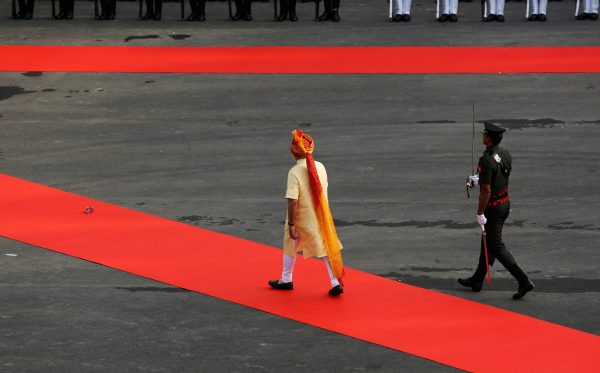When Modi came to power, the expectations for his economic policy initiatives rode high. But many of the big surprises on the upside he’s delivered have been in foreign policy.
Modi has certainly carved a new place for India on the global political stage. His energetic diplomacy has reinvented non-alignment and embraced engagement on many fronts, building partnerships with Israel and Iran, cementing them with Australia, Canada and Japan and reaching out to the smaller states of the Indian Ocean and South Pacific. The corridor to Africa has been a signature initiative in which Modi has been joined by Japan. India’s relations with its neighbours, Bangladesh and Sri Lanka, are on the up, though there’s still no breakthrough on Pakistan. The positive trajectory of US–India relations has continued with Modi’s trip to Washington in late June. And, despite their border dispute in Doklam, development of pragmatic cooperation has marked the important relationship with China. The success of their management of border problems is a testament to the under-appreciated depth and resilience of Sino–Indian ties overall.
There have also been wins on economic policy where Modi’s credentials promised significant change. Liberalisation of foreign investment regulation has seen a dramatic lift in direct investment from abroad. Demonetisation through revocation of large-denomination bank notes to limit tax avoidance and the introduction of the goods and services tax are other economic policy victories, though messily executed.
Improving governance is a key structural reform agenda in India. The Economist and other international observers have, perhaps unfairly, marked Modi down on governance reform because of his focus on building the capacities of a ‘development state’ rather than ‘maximising governance and minimising government’, Margaret Thatcher-style. But the other view, informed by Modi’s on-the-ground experience in Gujarat, suggests that investing capacities in the ‘development state’ is a necessary and critical condition for the success of further economic liberalisation.
Rajiv Kumar, Modi’s new head of NITI-Aayog, points out, a ‘development state’ is the antithesis of the ‘soft and rent-seeking state’ that has characterised India since independence. It’s essential to ensure effective security for the poor who are excluded by the market, Kumar argues. India cannot rely on substituting private solutions to what are palpably public problems. The outsourcing of basic public services has resulted, the argument runs, in exclusionary rather inclusive development since the initial reforms of 1991. Breakdowns in public schooling, basic health, public transport and power transmission networks are all evidence of the damaging outcomes of a soft and rent-maximising state.
But, as Amitendu Palit says in this week’s lead, there are major economic policy fronts on which Modi has yet to break through. The durability of the boost to India’s growth since Modi came to power will remain in question until there are decisive victories on labour market, land and international trade reform.
Palit points out that Modi was widely expected to push ahead with these core economic reforms and clean up the regulatory mess that make India a difficult place for doing business. His signature ‘Make in India’ initiative aimed at making India a global industrial powerhouse but the ‘global’ bit has yet to be delivered.
India’s large and rapidly growing population cries out for jobs. They will only be delivered through sustaining high and broad-based GDP growth. Millions of Indians remain trapped in low productivity, informal sector employment. Lifting the regulatory burdens on expanding formal employment and investment, especially in larger-scale manufacturing, is needed to help break the logjam. Modi’s biggest challenge is to create enough jobs to ensure that India’s demographic dividend does not turn out instead to be a massive liability.
The disconnection between Modi’s reform ambitions is nowhere more evident than in India’s inward-looking trade diplomacy. Trade reform is the critical complement to domestic regulatory reform and an outward-looking ‘Make it in India’ strategy. But Indian trade diplomats are reluctant and laggard partners in this signature endeavour. Where India could be positioning itself to ride the next great wave of trans-Asian trade and industrial integration through proactive engagement in the reform and liberalisation that East Asia’s Regional Comprehensive Economic Partnership (RCEP) promises, its approach to these negotiations thus far is to deliver little but lead in the saddle bags.
On these big issues, Modi might yet break through and have his way. The ruling Bharatiya Janata Party’s gains in this year’s state elections will deliver his government more political security next year through its impact of the composition of India’s upper house.
But now’s the time to set out India’s strategies to deal with its big economic vulnerabilities and, on the international dimension, craft a diplomacy with his peers in Asia over the next few months that defines Modi’s way forward on internationally grounded economic reform.
The EAF Editorial Board is comprised of Peter Drysdale, Shiro Armstrong, Ben Ascione, Amy King, Liam Gammon, Jillian Mowbray-Tsutsumi and Ben Hillman, and is located in the Crawford School of Public Policy in the ANU College of Asia and the Pacific.


Does Prime Minister Modi have an educational plan to put a lot of money into giving the Indians at the poorer segment of the population a first-class education including a vocational/university so they can escape poverty?